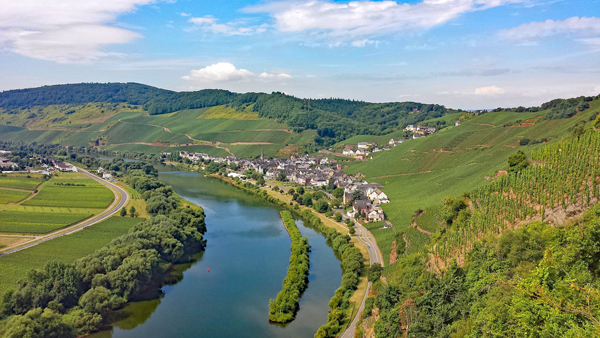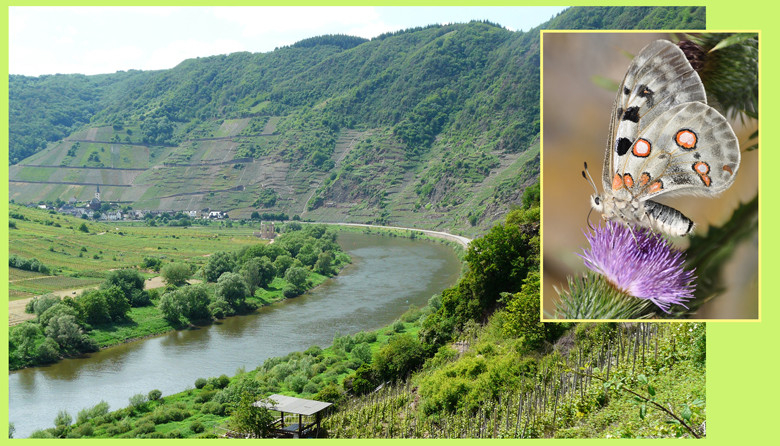Apollo butterfly versus helicopter spraying at the Terrassenmosel
Only the wine cultural landscape provides the favorable habitat
https://www.bonvinitas.com/media/reviews/photos/thumbnail/780x480c/59/8f/cb/apollo-butterfly-versus-helicopter-spraying-at-the-terrassenmosel-50-1752352025.jpgBecause only the viticultural cultural landscape provides the favorable habitat
 The Mosel near Ürzig. Photo: Pixabay
The Mosel near Ürzig. Photo: Pixabay
For many months, this conflict simmered, triggered by the "Working Group of Rhineland-Westphalian Lepidopterists" (butterfly experts), who, together with the German Federation for Environment and Nature Conservation (BUND) and the BUND NRW Nature Conservation Foundation, named the Mosel Apollo butterfly the Butterfly of the Year 2024. A good idea, actually! However, the ensuing campaign caused many vintners to take up arms. The aforementioned institutions claimed that the pesticides sprayed by helicopter for decades were responsible for the declining Apollo butterfly population. Consequently, a ban was demanded. However, after a thorough review of the facts, this hypothesis turned out to be very questionable because there were no relevant findings regarding the Apollo butterfly. Only when the butterfly's lifestyle was examined did it become clear that its developmental phases increasingly no longer correlate with the flowering of its food plants. Terrace vineyards are not natural landscapes but cultural landscapes created and maintained by humans over millennia. If vineyards are abandoned to nature, overgrowing brush chokes the unique steep-slope flora and fauna within a few years. Even if it doesn't fit some worldviews: only the intelligent use of plant protection products guarantees the preservation of viticulture, enables the continuation of the cultural landscape, and saves the Apollo butterfly.
Green light for the 2024 spraying campaign
The solution is a great relief and a huge step forward, said Maximilian Hendgen, Managing Director of the Mosel Winegrowers Association, in Koblenz. A ban on helicopter operations would have meant the end for many vintners, as there is no alternative for the steep slopes. Until now, for many vintners with steep vineyards along the Terrassenmosel between Bremm (Cochem-Zell district) and Winningen (Mayen-Koblenz district), plant protection for 2024 and the following years was unresolved. The reason was the Apollo butterfly. The rare and endangered butterfly is native there. The Federal Environment Agency (UBA), involved in the approval process for plant protection products, had called for increased protection of the butterfly. Therefore, there was initially no green light from the Federal Office of Consumer Protection and Food Safety (BVL) for helicopter application of plant protection products this year. According to the Ministry of Viticulture, studies show that the management of vineyards creates the necessary habitats for the Apollo butterfly. In overgrown landscapes, it hardly occurs, they say.
This is how the preservation of this unique landscape must be ensured
 In extreme steep slopes, cable cars or cog railways are also used especially for harvest. Here in Winninger Uhlen. Photo: Ralf KaiserWhat needs to be done? First of all, reliable findings must be obtained. Then targeted searches for alternatives must take place. The fact is that climate change and the decline in the Apollo butterfly population are directly linked. The Ministry of Viticulture also finds it incomprehensible to blame vintners for the decline of the butterfly. This opinion is also shared by vintner Kilian Franzen from Bremm, who cultivates vineyards in the "Bremmer Calmont," the steepest vineyard in Europe. "There are studies that link climatic changes to the decline in butterfly populations," says Franzen. But the preservation of these steep or terrace slopes is of existential importance not only for vintners. As defining elements of river landscapes, steep slopes also have special cultural landscape significance, explains the Federal Ministry of Agriculture: "Their socio-economic importance therefore goes far beyond wine production." The dry-warm steep slopes are also habitats for particularly protected animal and plant species that depend on being kept open by viticultural use. "We can only preserve steep-slope viticulture if we enable aerial crop protection," says DLR expert Porten.
In extreme steep slopes, cable cars or cog railways are also used especially for harvest. Here in Winninger Uhlen. Photo: Ralf KaiserWhat needs to be done? First of all, reliable findings must be obtained. Then targeted searches for alternatives must take place. The fact is that climate change and the decline in the Apollo butterfly population are directly linked. The Ministry of Viticulture also finds it incomprehensible to blame vintners for the decline of the butterfly. This opinion is also shared by vintner Kilian Franzen from Bremm, who cultivates vineyards in the "Bremmer Calmont," the steepest vineyard in Europe. "There are studies that link climatic changes to the decline in butterfly populations," says Franzen. But the preservation of these steep or terrace slopes is of existential importance not only for vintners. As defining elements of river landscapes, steep slopes also have special cultural landscape significance, explains the Federal Ministry of Agriculture: "Their socio-economic importance therefore goes far beyond wine production." The dry-warm steep slopes are also habitats for particularly protected animal and plant species that depend on being kept open by viticultural use. "We can only preserve steep-slope viticulture if we enable aerial crop protection," says DLR expert Porten.
Drones instead of helicopters?
 DroneA ban on helicopter use is at least off the table for 2024. Now there are plans for trials to demonstrate how drones could be used in the Terrassenmosel. For this purpose, a five-hectare area has been designated where drones will spray in summer. Environmental authorities also see drones as the tool to still be able to apply plant protection products in vineyards, says Norbert Müller, head of the Mosel Rural Service Center. Thus, drones are one of the key solutions to enable future wine production in steep-slope viticulture: "In summary, the use of drones in vineyards offers many advantages, but it is also associated with a complex approval process and certain restrictions."
DroneA ban on helicopter use is at least off the table for 2024. Now there are plans for trials to demonstrate how drones could be used in the Terrassenmosel. For this purpose, a five-hectare area has been designated where drones will spray in summer. Environmental authorities also see drones as the tool to still be able to apply plant protection products in vineyards, says Norbert Müller, head of the Mosel Rural Service Center. Thus, drones are one of the key solutions to enable future wine production in steep-slope viticulture: "In summary, the use of drones in vineyards offers many advantages, but it is also associated with a complex approval process and certain restrictions."
As soon as results on spray drift are finally available, the Julius Kühn Institute, responsible nationwide for plant protection, can carry out the technical recognition tests for drones. This would pave the way for legal and regulated drone use for fungicide application in steep-slope viticulture, explained Daniela Schmitt, State Secretary at the Rhineland-Palatinate Ministry of Viticulture.
Conclusion:
As so often before, hasty conclusions are not helpful and rather counterproductive. It is therefore advisable to think in overall contexts and act accordingly. The preservation of a probably unique landscape is paramount. Preserving it, thus securing the existence of an entire region and the people living and working there, is the highest priority. This does not exclude the constant search and striving for improvements. This can only be achieved together and not with mutual accusations.
Text: Horst Kröber






